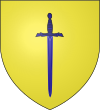Clan Spalding
| Clan Spalding | |
|---|---|
| Motto | Nobile Servitium (Service is noble) |
 |
|
| Clan Spalding has no chief, and is an armigerous clan | |
| Historic seat | Ashintully Castle |
Clan Spalding is a highland Scottish clan and sept of Clan Murray. The clan does not have a chief recognised by the Lord Lyon King of Arms so the clan is considered an armigerous clan. The Spalding family lived in Perthshire, Scotland, for several hundred years before 1745, and dispersed to Germany, Sweden, Jamaica, Georgia, Liverpool, Virginia and elsewhere. The Castle of Ashintully was the clan centre in Perthshire.
This name takes its origin from the town of Spalding, Lincolnshire. The name is recorded in Scotland as early as 1294, when John de Spaldyn, ‘Magister’ (Master) witnessed a grant of lands in Aberdeen. Another Spalding is mentioned as a canon of Elgin Cathedral around 1300. He is probably John de Spauyding, who petitioned Edward I of England in 1304 for timber to build his church at Duffus. The Spaldings came to prominence in 1318 at the siege of Berwick by Robert the Bruce. The story goes that Peter de Spalding, a burgess of Berwick, hated the English governor, and aided the besiegers in taking the town. He was rewarded by Bruce in May 1319 with the lands of Ballourthye and Pitmachie in Angus. He was also granted the keepership of the royal forest of Kylgerry. In 1587 the Spaldings appear in an act of the Parliament of Scotland as a clan for whom their chief, chieftain or captain, would be held responsible. The principal family were the Spaldings of Ashintully.
John Spalding was a lawyer and commissary clerk of Aberdeen in the reign of Charles I. He is the author of a famous historical work, Memorials of the troubles in Scotland and England from 1624 to 1645. His work was originally available only in manuscript form and was first printed in 1792, then reprinted in 1829. An antiquarian society known as The Spalding Club was founded and named in his honour.
...
Wikipedia
